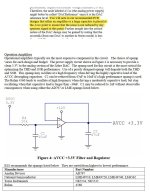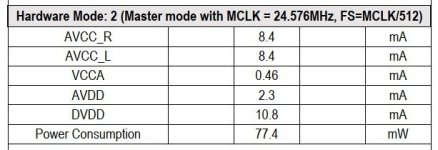Why? Because ultra-low noise regulators are fast devices and a large cap can not change fast enough its charge and this can end in resonance or overshooting? But if it's true, why not place the small caps directly close to the IC pins?ESS datasheet recommends using ultra-low noise regulators for the critical AVCC supplies. Typically large output capacitors should not be used with ultra-low noise regulators.
Typically ultra-low noise regulators require low ESL/ESR output capacitors due to high bandwidth. Of course you can and should add small caps (e.g. 100nF-1uF) close to IC pins. The critical supply in ESS dac chips is AVCC. Other supplies do not require ultra-low noise regulators.
LT3042 works well.which types of ULN regulators have proven good in this application?
Maybe ESS said bigger uF because the ESR is reduced with higher capacitance ? Tpically, the reg just charge the local faster (big) reservoir cap (several hundred uF ?
As engineer, the "problem" could be solved if I know three things: source - transmission line - load. But sadly, the load side is not known exactly, because it is a manufacturer's secret what's in the black box. The short recommendations and block shemes do not cover up that is going on exactly, what type of load is present. Re-engineering costs a lot of time, money and understandings. So, not an easy task... Or: we can simply copy an existing desing from a well-known device manufacturer and we hope the best...😉
9 out of 10 times exactly the datasheet recommendations. Who puts effort in internals of the IC?Or: we can simply copy an existing design from a well-known device manufacturer and we hope the best...😉
I'll make an effort if I will design a superb system. But sadly, classical reasonable engineering ist rarely possible if you don't know what to do, as I sad before... And that is the tragedy of humanity, that we do NOT share usefull informations! Only because of I will all the goods and huge profit for me alone, and the others should be the slaves. Disgusting, very-very sick....🙁
Thanks bohrok2610! I think so it is a good way to go. For Cset I've considered the Rubycon PML (polymer) caps too, but they need a larger footprint, min. 1210 as I remember.
Of possible interest: https://www.semanticscholar.org/reader/1a2d58e2494e04cd5ddb15046803c9edbed08146
That document is old and discusses noise below audio frequencies. Besides modern solid or polymer tantalum capacitors have improved characteristics.
Some takes from that document:
"Not too much should be read into these results because the number of samples was limited."
"v) There is some correlation between the magnitudes of the leakage current and the noise
current. A small d.c. leakage indicates that the noise is probably low."
Modern tantalum capacitors have small d.c. leakage.
Some takes from that document:
"Not too much should be read into these results because the number of samples was limited."
"v) There is some correlation between the magnitudes of the leakage current and the noise
current. A small d.c. leakage indicates that the noise is probably low."
Modern tantalum capacitors have small d.c. leakage.
They measured 32 capacitors in total. I remember threads on this forum where we drew conclusions based on measurements on only one capacitor.
Due to the multiplying of a DAC (its output is essentially the digital input signal times the voltage reference times some dimensionless constant), subsonic noise on the reference gets converted to audio-frequency noise skirts around the desired signal. Skirts at 0.01 Hz offset should be pretty well masked, though.
It makes sense that the excess noise increases with leakage current. At least without any leakage current, they could not generate any noise other than the thermal noise of their ESR. If they would generate more noise, you could take two of these tantalum capacitors and a resistor and connect the components in (anti-)series, minus pole of one tantalum capacitor connected to the minus of the other. After charging the capacitors to the same bias voltage, you would then indefinitely have a net noise power flow from the capacitors to the resistor without any power supply, violating the second law of thermodynamics. With leakage, you need to periodically recharge them, so there is no violation.
Due to the multiplying of a DAC (its output is essentially the digital input signal times the voltage reference times some dimensionless constant), subsonic noise on the reference gets converted to audio-frequency noise skirts around the desired signal. Skirts at 0.01 Hz offset should be pretty well masked, though.
It makes sense that the excess noise increases with leakage current. At least without any leakage current, they could not generate any noise other than the thermal noise of their ESR. If they would generate more noise, you could take two of these tantalum capacitors and a resistor and connect the components in (anti-)series, minus pole of one tantalum capacitor connected to the minus of the other. After charging the capacitors to the same bias voltage, you would then indefinitely have a net noise power flow from the capacitors to the resistor without any power supply, violating the second law of thermodynamics. With leakage, you need to periodically recharge them, so there is no violation.
My AK4493 DAC that uses a tantalum capacitor at LT3042 Cset has about 20dB lower close-in noise skirts than RTZ dac with same clocking. Since same clock is used in both cases either the clock circuit in RTZ causes higher phase noise or the amplitude noise of RTZ is much higher. Hence I have no trouble recommending tantalum capacitor at LT3042 Cset.
Chances are that the aluminium electrolytic capacitor I used in the RTZ shift register DAC also has 1/f noise on its leakage current. I never measured it, but I can't think of any reason why it would be unique to tantalum capacitors.
Can I ask what brand and type of tantalium capacitor do you use?My AK4493 DAC that uses a tantalum capacitor at LT3042 Cset has about 20dB lower close-in noise skirts than RTZ dac with same clocking. Since same clock is used in both cases either the clock circuit in RTZ causes higher phase noise or the amplitude noise of RTZ is much higher. Hence I have no trouble recommending tantalum capacitor at LT3042 Cset.
- Home
- Source & Line
- Digital Line Level
- ES9017/27 DAC design


